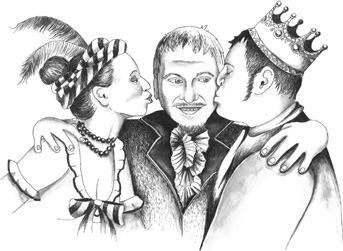
GEORGIE Porgie, pudding and pie,
Kissed the girls and made them cry;
When the boys came out to play,
Georgie Porgie ran away.
There is a sinister undertone to this nursery rhyme; Georgie Porgie really seems to be up to no good, otherwise the girls would not be crying and he would not have to run away when the boys came out to play. So what is it all about, then? There are two Georges whose stories fit the events. One was George Villiers (1592-1628), the handsome son of an insignificant nobleman but who soon climbed his own way into the court of James I and the king’s favour. Aged just twenty-three, he was given the somewhat unnerving position of Gentleman of the Bedchamber.

Rumour had it that he and the king were more than good friends. It certainly would explain why within two years he had been made an earl and then a marquess. Five years later, aged just thirty-one, George became the 1st Duke of Buckingham, proving quite clearly that the king’s bedchamber was the place to be for any aspiring nobleman in the early seventeenth century.
The nursery rhyme is said to mock both James I and George Villiers over their open romantic interest in each other. In fact, the king even proclaimed to the Privy Council that ‘you may be sure that I love the Duke of Buckingham more than anybody else and I wish not to have it thought to be a defect’. Although the king once announced that homosexuality was among the crimes that ‘we are bound in conscience never to forgive’, it is now believed by historians studying court diaries and correspondence that the pair were indeed lovers. The king even called Georgie ‘my sweet child and wife’ as if to emphasize the point.
But George Villiers was also known to be partial to both sexes and had many affairs with both the young ladies of court and the wives and daughters of other powerful Englishmen, causing resentment all around, although his relationship with the king gave him a certain amount of immunity. It had also been whispered that he often took advantage of his privileged position and forced his affections upon the said ladies, causing outrage (Kissed the girls and made them cry) while managing to avoid confrontation or retaliation (When the boys came out to play, / Georgie Porgie ran away).
George Villiers’s luck eventually ran out when, in 1627, he became embroiled in military matters and led an unsuccessful campaign on behalf of James’s son, Charles I, during which the former rent-boy-made-good accidentally lost over four thousand men out of an army of seven thousand. On his return to Portsmouth, he was stabbed to death by one of the wounded soldiers, furious at his commander’s lack of military judgement and the loss of so many of his English comrades. ‘Georgie Porgie’ was laid to rest at Westminster Abbey later that year.
Another candidate for the real Georgie Porgie is the Prince Regent George IV, the hapless son, with half an inch of brain, of mad King George III (see The Grand Old Duke of York). Immensely fat (Georgie Porgie, pudding and pie), his corset-wearing was the source of constant ridicule and satirical cartoons. By 1797, his weight had reached seventeen and a half stone and by 1824 his corsets were being made for a waist of fifty inches.
This George was unquestionably heterosexual but he took as much advantage of his position as George Villiers had done. He had a roving eye: attractive female visitors to the parties he gave at the Pavilion in Brighton were often advised to avoid being left alone with him. His chequered love life involved several mistresses, illegitimate children and even bigamy. He had an official wife, Caroline of Brunswick, whom he detested so much he even banned her from his coronation, and an unofficial one – Maria Anne Fitzherbert (as she was both a Catholic and a commoner, their marriage was not formally recognized and remained a secret) – and he managed to make both women miserable (Kissed the girls and made them cry).
In addition, although George loved watching prizefighting (bare-knuckle boxing), which at that time was illegal, his own physical and emotional cowardice was legendary. This is illustrated by a story of the most infamous prizefight of the day, where one contestant died of his injuries. George was known to have been present, as he was included in a sketch of the match by James Gillray (the famous political cartoonist), but when the man died he ran away, terrified of being implicated in the fallout and attempting to conceal his presence at the match (When the boys come out to play, / Georgie Porgie ran away).